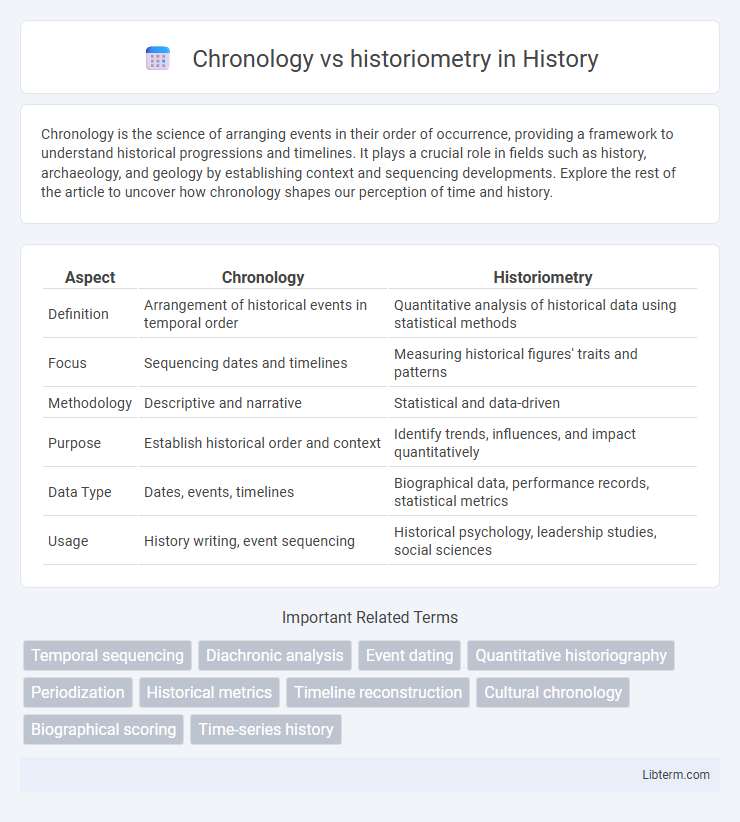Chronology is the science of arranging events in their order of occurrence, providing a framework to understand historical progressions and timelines. It plays a crucial role in fields such as history, archaeology, and geology by establishing context and sequencing developments. Explore the rest of the article to uncover how chronology shapes our perception of time and history.
Table of Comparison
| Aspect | Chronology | Historiometry |
|---|---|---|
| Definition | Arrangement of historical events in temporal order | Quantitative analysis of historical data using statistical methods |
| Focus | Sequencing dates and timelines | Measuring historical figures' traits and patterns |
| Methodology | Descriptive and narrative | Statistical and data-driven |
| Purpose | Establish historical order and context | Identify trends, influences, and impact quantitatively |
| Data Type | Dates, events, timelines | Biographical data, performance records, statistical metrics |
| Usage | History writing, event sequencing | Historical psychology, leadership studies, social sciences |
Introduction to Chronology and Historiometry
Chronology establishes the sequential order of historical events, providing a structured timeline essential for understanding temporal relationships. Historiometry applies quantitative methods and statistical analysis to historical data, aiming to measure and interpret patterns in human behavior and achievements over time. Together, these approaches enhance the precision and depth of historical research by combining temporal frameworks with empirical evaluation.
Defining Chronology: Mapping Historical Events
Chronology involves the systematic arrangement of historical events in sequential order to establish a clear timeline. Precise dating methods like radiocarbon dating and dendrochronology enhance the accuracy of chronological mapping. Chronology serves as the foundational framework for analyzing historical causality and contextual relationships.
Understanding Historiometry: Measuring Historical Impact
Historiometry quantifies historical impact by analyzing measurable data such as the frequency of mentions, influence on subsequent events, and the longevity of contributions from historical figures. Unlike chronology, which simply orders events by date, historiometry utilizes statistical and computational methods to evaluate significance and lasting effects. This approach offers a nuanced understanding of historical influence, enabling researchers to identify key drivers of change across different eras.
Key Differences Between Chronology and Historiometry
Chronology involves the sequential arrangement of historical events by date, emphasizing precise timelines and temporal relationships. Historiometry measures and analyzes quantitative data from historical figures and events, applying statistical methods to assess patterns, such as leadership traits or societal impact. Key differences include chronology's focus on temporal ordering versus historiometry's emphasis on data-driven evaluation and predictive analysis within historical research.
Methodologies in Chronological Research
Chronological research methodologies emphasize the precise ordering and dating of historical events using calendars, timelines, and archival records to establish temporal frameworks. Techniques include cross-referencing primary sources, astronomical dating, and dendrochronology to verify event sequences accurately. This approach contrasts historiometry, which applies quantitative analysis and statistical methods to evaluate historical figures and phenomena.
Techniques Used in Historiometric Analysis
Historiometric analysis employs quantitative techniques such as statistical modeling, mathematical scoring, and content analysis to evaluate historical data and psychological traits of notable individuals. Techniques include regression analysis to identify patterns, factorial analysis for trait classification, and cluster analysis to group historical phenomena with similar attributes. Cronology typically arranges events in temporal sequence, while historiometry focuses on empirical data measurement and interpretation for deeper psychological and sociological insights.
Applications of Chronology in Historical Studies
Chronology serves as a fundamental tool in historical studies by providing a precise timeline that enables historians to sequence events accurately and analyze their causal relationships. By establishing reliable dates through various methods such as dendrochronology, radiocarbon dating, and astronomical correlation, chronology supports the validation and contextualization of historical narratives. Its application enhances the reconstruction of historical periods, aids in cross-cultural comparisons, and strengthens the overall integrity of historiographical research.
The Role of Historiometry in Evaluating Influence
Historiometry employs quantitative methods to analyze historical data, enabling the measurement of individual influence through metrics like publication counts, citations, and leadership roles. Unlike traditional chronology, which sequences events linearly, historiometry provides objective evaluation of impact by statistically comparing contributions across time and fields. This approach reveals patterns of influence and helps identify key figures whose actions shaped historical developments beyond mere event placement.
Challenges in Chronology and Historiometry
Chronology faces challenges such as reconciling inconsistent historical records, managing gaps in data, and establishing precise timelines across different cultures and calendars. Historiometry encounters difficulties in quantifying historical data, addressing subjective interpretations, and ensuring the reliability and validity of statistical analyses applied to historical figures and events. Both fields require sophisticated methodologies to overcome biases, incomplete sources, and the complex nature of human history.
Integrating Chronology and Historiometry for Deeper Insights
Integrating chronology and historiometry enhances the analysis of historical events by combining accurate timelines with quantitative evaluation of historical figures' impacts. Chronology provides a structured sequence of events, while historiometry applies statistical methods to assess influence, leadership, and decision-making patterns within that timeline. This synthesis enables deeper insights into cause-effect relationships and the significance of individual contributions throughout history.
Chronology Infographic

 libterm.com
libterm.com